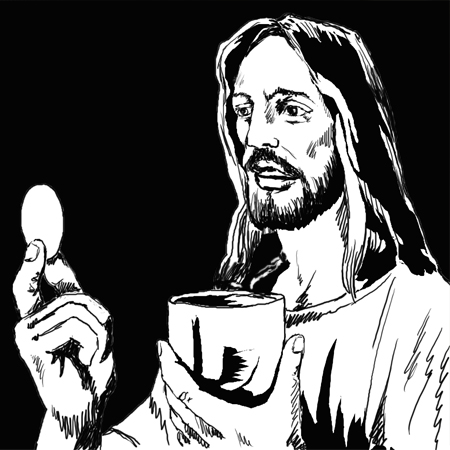 Body and Blood of Christ, Year B
Body and Blood of Christ, Year B
Ex 24:3-8; Dt 9:11-15; Mk 14:12-16, 22-26
Introduction: This is a homily/Scripture reflection in a book, titled: ‘Every Week God Speaks We Respond’, Cycle B, intended to be published in the future by Reverend John Tran Binh Trong.
It was published in Vietnamese in the US 2008 and republished in Viet Nam 2011. To keep the author’s writing style, this homily has not been edited and may not be by a hired hand. However, if readers would like to point out mistake(s) in spelling and grammar and/or to suggest English phrases and expressions, it would be greatly appreciated by the author, whose English is not his mother tongue and who did not live in the US until his adulthood. Passive sentences are used intentionally in this context as to avoid using the first personal pronoun ‘I’ when applicable, that might be associated with any idea of egotism, in accord with the French saying, known as: ‘Le moi est haissable’ (The ego is detestable).
Before ascending into heaven, Jesus did not leave his apostles orphaned, he gave them and through them to us, his body and blood to be our spiritual food and drink, to be our strength, hope and consolation saying: This is my body (Mk 14:22).
Then he took the cup of wine saying: This is my blood, the blood of the covenant to be poured out on behalf of many (Mk 14:24). The new covenant between God and his people
was not ratified with sacrificial blood of sheep and goat, which Moses used in the Old Testament (Ex 24:6-8), but with the blood of God’s Son as Jesus said in today’s Gospel and recorded by Saint Paul’s letter to the Hebrews (Heb 9:14). To continue the Eucharist, he also instituted the priesthood to celebrate mass. The mass is the renewal of the sacrifice on the cross. To participate in the Eucharistic banquet is a sign that we accept the new covenant with God. If we, Catholics were asked whether they would believe in Jesus’ presence in the Eucharist, the answer would be yes. That is the difference between Catholics and Protestants.
The Catholics believe in the real presence of Christ in the Eucharist, because of the consecration of bread and wine at mass by the priest celebrant. Jesus’ presence in the Eucharist is a mystery, which we can only accept by faith. That is why after the consecration of the bread and wine, the priest celebrant call upon us to proclaim the mystery of faith. However, sometimes doubt about Jesus’ presence in the Eucharist might creep in. Did we ever hear a voice of temptation telling us what not to believe, what not to do, what to be reconsidered? Did we ever doubt whether the bread and wine would be
turned into the body and blood of Christ, when the priest celebrant proclaimed the word of consecration: This is my body. This is the cup of my blood. The reason for that is the bread and wine after the consecration does not look different from the bread and wine before the consecration.
If the bread and wine had not been transformed into the body and blood of Christ at the consecration, then would have all the masses celebrated on the altar all over the world so far been invented. Can it really be so that since Jesus instituted the Eucharist and the ordination of the priesthood, myriads of worldwide priests have proclaimed the word of consecration and have not believed in the real transformation? If they had not believed in the real presence of Christ in the Eucharist, how could they continue to celebrate mass? Supposedly, some priests sometime had doubt about the presence of Jesus in the Blessed Sacrament. Happily, the moments of doubt would not last long for them.
In the year of 1263, a German priest was well known for his prudence and high morals. Yet he was much doubtful in faith about how the word of consecration by a priest could transform bread and wine into the body and blood of Christ? On a certain occasion, he went to Bolsena, Italy for a visit and asked to celebrate mass in the church of Saint Christina. At the consecration, seeing the Host appeared as true bloodstained flesh and blood dropped from the consecrated host on the corporal, he was terrified, stopped celebrating the mass, put the consecrated Host in the tabernacle. With deep repentance, he hurried to go and confess his sin of doubt to Pope Urban I who, resided at Orvieto at that time.
The Pope brought the Blessed Sacrament by the miracle with reverence to the church in Orvieto and placed in the tabernacle. That was the first Eucharistic procession in the Church. In the following year 1264, he established the feast of Corpus Christi. This Eucharistic miracle is displayed for people to see annually on the Solemnity of the Body and Blood of Christ. Besides there have been more Eucharistic miracles happened in Italy (1).
We suppose Catholics believe in their mind that Jesus is present in the Eucharist, and when we receive communion, we receive the Body of Christ. However, whether to feel his presence is a different story. In order to feel his presence in the Eucharist, Jesus invites us to respond to his invitation: Come to me, all of you who are weary and find life burdensome, and I will refresh you (Mt 11:28).
In order to experience his presence in the Eucharist, we are asked to spend some time with the Lord, praying and worshipping before the Blessed Sacrament, to put our burdens of life: our sadness, our suffering, our shame and our sorrow into His heart.
To express ourselves outwardly before God when we come to church to attend mass or to pray in the presence of others might be difficult for shy people. If so, it’s better to come and pray before the Eucharist at a quiet time on a retreat so that we can choose to be alone with the Lord, to express ourselves before the Eucharist, or to just sit there contemplating in silence, letting heart talk to heart.
Before the Eucharist, if we feel like crying, we can let our tears flow out. That could be tear of suffering, tear of repentance, tear of fear and worry, tear of loneliness and frustration. A certain priest decided to make a silent retreat at a small monastery in a rural area. In the evening, he entered the chapel, kneeling just a few feet in front of the tabernacle with the presence of the Eucharist. Before he could say anything, his tears flowed out continuously, wetting his cheeks. His life changed since then.
When Mother Teresa of Calcutta was asked how she could continue her daily work serving poor people in India from a day-to-day basis like that. She answered she got her strength from the Eucharist and she spent hour and hour praying before the Lord in the Eucharist.
Jesus told us through Peter: You could not stay awake (with me) for even one hour (Mk 14:37)? To respond to Jesus’ invitation, we are asked to spend some time with the Lord in the Eucharist. If we do not feel anything for the first time, we can try again and again, to see if the word of God and the Body of Christ are real; if the word of God can touch our hearts and transform our lives, if the Lord can be our strength, our joy, our hope and
our reason to live? A moment of intimacy with the Lord comes to each person at a different time, different circumstance, and different occasion. No one is similar to another. Here the word of Psalm tells us: Taste and see how good the Lord is; Happy the man who takes refuge in him (Ps 34:9).
Prayer for feeling God’s presence in the Eucharist:
Oh Jesus present in the Eucharist!
When I kneel down before the Tabernacle by myself
with your presence in the Eucharist,
awaken my mind and heart
so that I may experience your real presence in there.
May I realize that you are waiting for me
to express myself before you.
Whisper to my ears
so that my heart can hear you.
Give me a sign
so that I may never forget you. Amen.
________________________________
-
Eucharistic miracle is summarized from: Coggi, R. Little Catechism on the Eucharist. New Hope, Kentucky. New Hope Publication, 2005, p. 62-65.



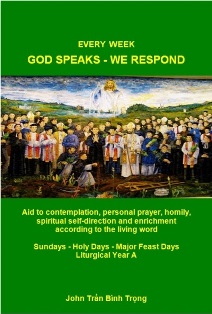 Every Week God Speaks – We Respond, Cycle A was published Online in the US. The introduction of the book is recorded at “Sách của Tác giả Chủ trương, Column 1.
Every Week God Speaks – We Respond, Cycle A was published Online in the US. The introduction of the book is recorded at “Sách của Tác giả Chủ trương, Column 1.

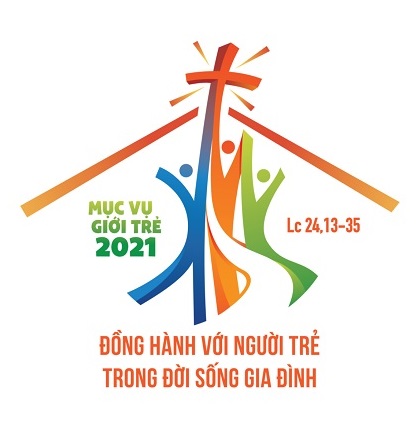 Năm Mục Vụ Giới Trẻ 2021. HĐGM ấn định một chương trình Mục vụ Giới trẻ 3 năm với các chủ đề tương ứng: Năm 2020: Đồng hành với người trẻ hướng tới sự trưởng thành toàn diện.
Năm Mục Vụ Giới Trẻ 2021. HĐGM ấn định một chương trình Mục vụ Giới trẻ 3 năm với các chủ đề tương ứng: Năm 2020: Đồng hành với người trẻ hướng tới sự trưởng thành toàn diện.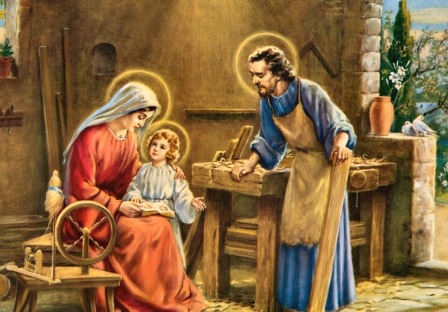 Năm Thánh Giu-se: Nhân kỷ niệm 150 năm Đức Giáo hoàng Pio IX chọn thánh Giuse làm Đấng Bảo Trợ Giáo Hội Công Giáo, Đức Phanxicô đã ban hành Tông thư “Patris corde” – Trái tim của người Cha – và công bố “Năm đặc biệt về thánh Giuse” từ
Năm Thánh Giu-se: Nhân kỷ niệm 150 năm Đức Giáo hoàng Pio IX chọn thánh Giuse làm Đấng Bảo Trợ Giáo Hội Công Giáo, Đức Phanxicô đã ban hành Tông thư “Patris corde” – Trái tim của người Cha – và công bố “Năm đặc biệt về thánh Giuse” từ 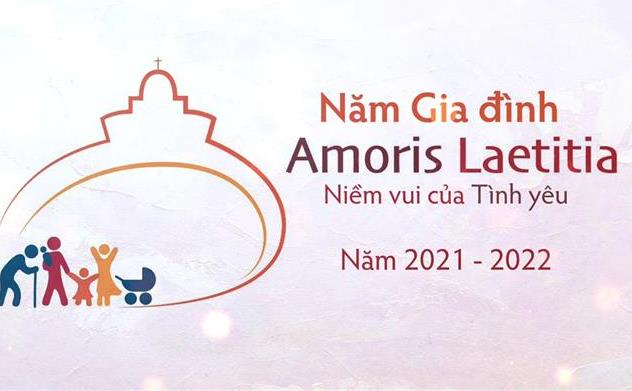 Năm “Gia đình Amoris Laetitia” 2021 về “Vẻ đẹp và niềm vui của tình yêu gia đình” do Bộ Giáo Dân, Gia Đình và Sự Sống tổ chức, được Đức Phanxicô khai mạc dịp Lễ Thánh Giuse
Năm “Gia đình Amoris Laetitia” 2021 về “Vẻ đẹp và niềm vui của tình yêu gia đình” do Bộ Giáo Dân, Gia Đình và Sự Sống tổ chức, được Đức Phanxicô khai mạc dịp Lễ Thánh Giuse 
